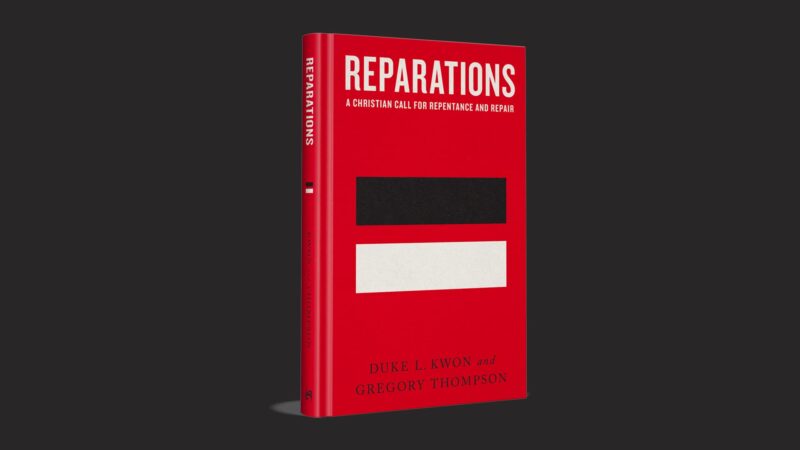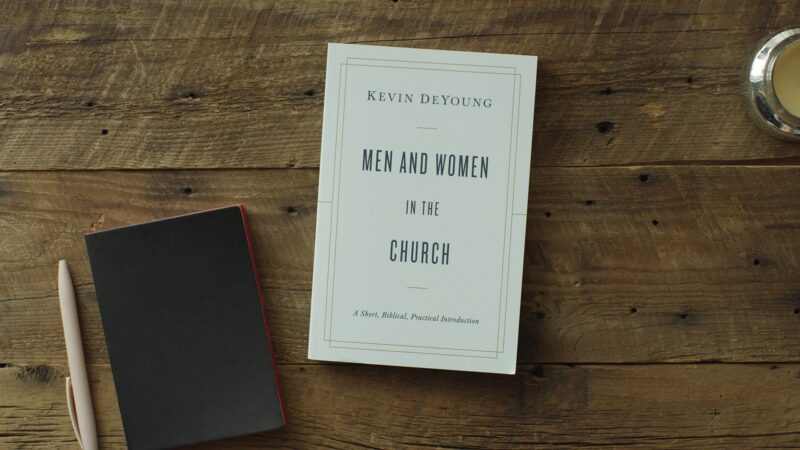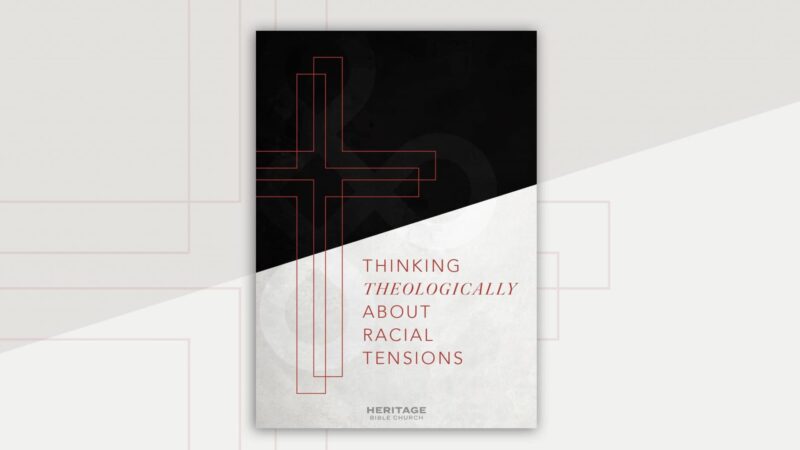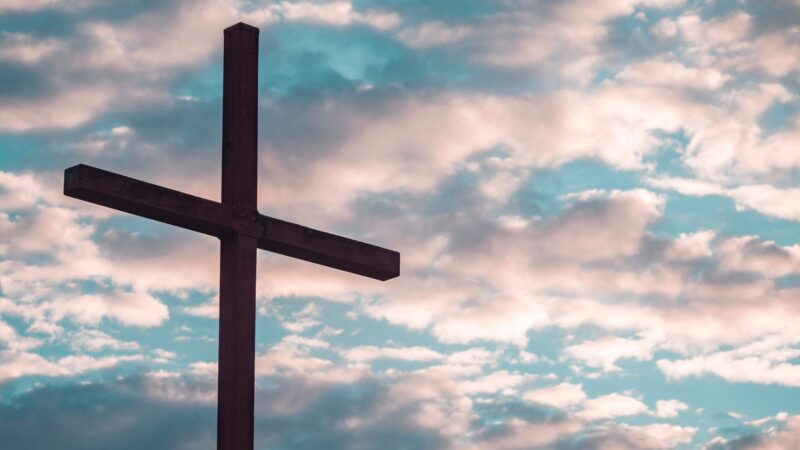Reparations: A Critical Theological Review
This post can also be viewed and printed in PDF.
Reparations: A Christian Call for Repentance and Renewal (Brazos Press) is a new book by Duke Kwon, a PCA pastor in Washington, DC, and Greg Thompson, a former PCA pastor (previously serving a church in Charlottesville, Virginia) who now leads a number of initiatives related to race and racism in America. Reparations is a bold work, calling for nothing less than for the language of White supremacy and reparations to be “fixed in the church’s imagination and fundamental to its vocation” (28). In simple terms, the problem is White supremacy, and the answer is reparations—restitution for what has been taken and restoration unto wholeness. Reparations is the cry of the ages and the call of the church (207).
With only 200 pages of text and over 30 pages of endnotes, Kwon and Thompson have written a book that is both accessible and academic. The writing is clear and excellently organized. Kwon and Thompson have a knack for breaking down complex ideas into helpful categories. For example, they argue that racism can be understood in four ways: as personal, with the need for repentance; as relational, with the need for reconciliation; as institutional, with the need for reform; or cultural, with the need for repair (32-44). There are more lists and rubrics like this throughout the book, many of them insightful and useful.
Kwon and Thompson are also to be commended for avoiding the history-as-screed template. The tone is strong at times, but never incensed. If readers have only viewed American history with rose-colored glasses, they will be helped to see the uncomfortable truth that racism in America has been far too pervasive and that the White church—with some noble exceptions mentioned in the book—has far too often been part of the problem instead of the solution. The authors have plenty of criticism for White Americans and for the White church in America, but they want to persuade not merely scold. To that end, they have put forward the most compact and most learned Christian defense of reparations to date. Well written and thoughtfully presented, this is an important book that deserves to be taken seriously.
Critical Engagement
It is also a book with which I have profound disagreements.
Reparations is a far-reaching indictment of American history and life in America as it exists today. Kwon and Thompson are right to show us the failures in our national history and in our churches; what’s more debatable is whether racism and White supremacy are embedded in every institution and encoded in every aspect of our society. One can be honest about our nation’s sins and shortcomings while still insisting that America wasn’t founded on White supremacy. Likewise, one can question whether “White supremacy”—with the images of Klansmen and Neo-Nazis it conjures up—is the best term to describe the whole warp and woof of American history, especially when heroes like Frederick Douglass and Martin Luther King Jr. often appealed to the Founders and their ideals. As a point of historical fact, it also bears mentioning that Kwon and Thompson wrongly assert that 12 million human beings were “caught in the slave trade between the fifteenth and nineteenth centuries in America” (87), when the total number of slaves brought to America was just over 300,000, with the vast majority going to Brazil and to the Caribbean. They appear to have interpreted Orlando Patterson’s estimate of enslaved Africans brought to the New World as a statement about America only. None of this is to downplay the horror and the injustice of the Transatlantic slave trade (slavery isn’t less horrible for having gone to other countries besides America), but misstating a historical number by a factor of 40 is worth noting.
But I don’t want to provide a historical analysis of Reparations. Neither do I want to focus on the sociological and economic claims of the book (though underlying the book’s criticisms are the unstated convictions that racial disparities are obvious signs of culturally embedded racism and that Western capitalism is a White supremacist system of “extraction” that harms the poor). Neither am I going to attempt to sketch my assessment of race in America or to offer a ten-step plan for moving forward (this is, after all, a book review). Instead, I want to provide a theological assessment of the book’s theological claims. For at the heart of Reparations is a moral argument—indeed, a Christian argument—about justice. “Reparations,” according to Kwon and Thompson, “is best understood as the deliberate repair of White supremacy’s cultural theft through restitution (returning what one wrongfully took) and restoration (restoring the wrong to wholeness)” (17). Consequently, “Reparations are not primarily given in light of a hoped-for-future; they are given in light of an actual past” (25). In other words, reparations are about what we owe and what is due. Kwon and Thompson call “the Christian church in America to embrace reparations as central to faithful Christian mission in this culture” (210). This is the key theological and ethical claim—one that I find ultimately ambiguous, unworkable, and unpersuasive.
Restitution
When people hear “reparations” they usually think of compensation for past injustices, some sort of redress for crimes committed. Reparations is the act of making amends, of giving satisfaction for wrongs or injuries. Kwon and Thompson begin and end the book with the story of the former slave Jourdon Anderson and the famous letter he wrote to his former master asking for his wages for 32 years of service. In effect, Anderson’s letter says, quite powerfully, “You’ve defrauded me all these years. Now you want me to come back and live with you and believe that you will treat me kindly? Give me back all that you stole, and then I’ll take your gesture of good will seriously.”
Kwon and Thompson frame the book with this story to help us see that reparations is about returning what has been stolen. They write early in the book, “When you take something that does not belong to you, love requires you to return it” (17). This theme shows up most clearly in their chapter on restitution. Their anchor text is the story of Zacchaeus from Luke 19. When Zacchaeus had his heart changed, he didn’t just pray a prayer or say he was sorry for cheating people. He showed his repentance by making restitution. Kwon and Thompson rightly summarize the basic lesson of Zacchaeus: “If you steal something, you have to give it back” (143). With an impressive array of citations from well-respected theologians through the ages, Kwon and Thompson remind us that true repentance is not found in words alone. “Generations of readers of Scripture across church history,” they argue, “have repeatedly affirmed restitution as an enduring Christian responsibility and a foundational expression of God’s unchanging moral law” (142).
All of that is wise, good, biblical, true, and necessary. The problems come when Kwon and Thompson apply this straightforward principle of restitution—in their words: “when you take something that does not belong to you, love requires you to return it”—and apply it to an evil as far off as slavery or a sin as nebulous as White supremacy. For example, after referencing a 1715 pamphlet condemning slavery and calling for Blacks to be “restored out of the Property of him that hath wronged them” (134), Kwon and Thompson conclude that “Restitution for the thefts of White supremacy is an old idea” (136, italics in original). But that’s not exactly true. What is an old idea is for masters to release their slaves and to make reparations for the wrongs they had committed against them. Throughout the history of this country people have written—rightly and forcefully—of the Christian duty to repay what one had stolen, to make restitution for wrongs done to the slaves, and to return what had been forcibly taken from another. There is no talk, however, about something as amorphous as restitution for “White supremacy.”
Later in the same chapter, Kwon and Thompson cite a petition from enslaved Christians demanding compensation for their “Long Bondag [sic] and hard Slavery.” Kwon and Thompson summarize: “In other words, they sought restitution for White supremacist theft” (155). It may seem like splitting hairs, but the language matters. Restitution makes perfect sense, and is imminently biblical, when the person who cheated pays back the person whom they cheated. Zacchaeus did not make restitution with the world or with every poor person in Judea. Instead, he sought to “restore fourfold” (according to Exodus 22:1) anyone he defrauded (Luke 19:8). Slavery may have been ungirded by (and helped perpetuate) assumptions of White superiority but to say that restitution for the theft of White supremacy is an old idea, is to smuggle back into the past the notion that restitution might be based on skin color or based on wrong attitudes or based on something as amorphous as participating in certain systems and structures.
The concept of White supremacy does a lot of heavy lifting throughout the book. For Kwon and Thompson, White supremacy is the evil that has been essential to America’s past and remains inescapable in the present. One can question, however, whether the category obscures more than it illuminates. To be sure, very few White Americans prior to the Civil Rights movement held views about Black Americans that we would consider acceptable today. We should not gloss over this sad history. In so far as White supremacy entails believing and acting as if your racial or ethnic identity makes you superior to others, it should be repudiated wherever it is found. And yet, when “White supremacy” covers everything from the horrors of slavery and lynching to the more common blindspots of self-centeredness and indifference, the result is that little effort is made to understand people in their own time and on their own terms. Moreover, the category of White supremacy, as a totalizing heuristic device, often lacks basic Christian charity in so far as it measures peoples, churches, and nations by their worst failures (as we see them) and pathologizes everyone and everything associated with the sin of partiality as being complicit with the most egregious catalog of sins in our nation’s history.
The language Kwon and Thompson use with reference to Zacchaeus is also telling: “Acknowledging that he, as a tax collector, stood at the center of an extractive system designed to plunder the most vulnerable members of a society, Zacchaeus offers half of his possessions to the poor” (139). True, Zacchaeus generously gave away half of his possessions to the poor in addition to making restitution for those he sinned against. But did he really acknowledge complicity in an “extractive system designed to plunder the most vulnerable members of society”? If he felt complicit in the whole system of tax collecting, why do we have no record of him leaving the profession? Why did Jesus show kindness to tax collectors (even calling one to be his disciple) without ever commanding them to leave their “extractive system” behind? When the tax collectors came to John the Baptist to be baptized and asked, “What shall we do?” John did not reprimand them for being part of a system designed to plunder the poor. He told them much more simply, “Collect no more than you are authorized to do” (Luke 3:13). Similarly, neither John the Baptist nor Jesus ever castigated Roman soldiers for being complicit in an imperial system designed to maintain Rome’s control over subjugated peoples. Instead, John told them to stop cheating, stop threatening, stop lying, and be content with their wages (Luke 3:14). With tax collectors and soldiers throughout the Gospels, there is no talk of restitution for imperial supremacy or extractive systems, nor any summons to dismantle the structures they inhabited, just the straightforward command to live a godly life, be generous to others, and repay what you have stolen.
The other problem with Kwon and Thompson’s argument is that the principle of restitution is much more difficult to apply with the passage of time. Each chapter of Reparations begins with a story from history, always a story that focuses on an injustice from the past or on someone trying to remedy injustice. These opening stories are, in order, from 1865, 1968, 1852, 1826, 1969, 1684, 1803, 1968, and 1865. While it is important to know the history of these injustices, it is less clear whether these injustices from the past necessitate restitution in the present.
One of the sources Kwon and Thompson cite several times is John Tillotson’s Two Sermons on the Nature and Necessity of Restitution (1707). Kwon and Thompson emphasize how strongly Tillotson insists on restitution as a sign of true repentance when property, wealth, or reputation are stolen. Tillotson’s messages on Zacchaeus are a fine pair of sermons. I don’t think I disagree with anything in them. But there is a section from Tillotson’s two sermons that Kwon and Thompson do not mention, and it undermines one of the central arguments of their book. Here is Tillotson in his second sermon on Luke 19:8-9:
But before I leave this head, there is one case very proper to be considered, which relates to this circumstance of time, and that is concerning injuries of a very ancient date; that is, how far backward, and whether it doth not expire by tract of time. . . . When the injury is too old that the right which the injured person had to reparation is reasonably presumed to be quitted and forsaken, then the obligation to satisfaction ceaseth and expires. . . . To illustrate this rule by instances: The Saxons, Danes, and Normans did at several times invade and conquer this nation, and conquer’d it we will suppose unjustly, and consequently did hold and possess that which truly belonged to others, contrary to right; and several of the posterity of each of these probably to this day hold what was then injuriously gotten; I say, in this case, the obligation to satisfaction and restitution is long since expired. . . . [C]onsidering the necessities of the world, and the infinite difficulties of retrieving an ancient right, and the inconveniences and disturbances that would thereby redound to human society, it is better than an injury should be perpetuated than that a great inconvenience should come be endeavoring to redress it. . . . And tho’ the instances I have given of the unjust conquest of a nation be great and publick; yet the same is to be determined proportionally in less and particular cases. (Two Sermons on the Nature and Necessity of Restitution, 45–47)
In other words, in the midst of two sermons strongly advocating for reparations (the word is used often), Tillotson acknowledges that, unfortunately, in a fallen world you can’t go back in time and right every wrong. Sometimes there are “infinite difficulties” which prohibit us from determining who was wrong, who did the wrong, and how restitution could possibly be made in the present without inflicting new wrongs. Sometimes the “necessities of the world” make restitution for crimes committed in the past impossible.
This does not mean restitution can never be paid years after a sin was committed. The obligation to make restitution may transfer to descendants, not because they bear personal guilt for previous sins, but because they are still in possession of the stolen goods (149). To this point, Kwon and Thompson give a useful example. Suppose your mother gives you a car. You enjoy it for years, until one day a stranger knocks on the door and says, “That car is mine!” You look in the glove box and sure enough, his name is on the title. You’ve been driving a stolen car. You can honestly say, “I didn’t know it was stolen.” You are not to be blamed for the theft. But the car clearly belongs to him, and you should give it back (149). Fair enough, but what if the man’s name was not on the title? What if it was the man’s great-great-grandson looking for the car? Or what if you purchased the car off the lot and the title was always in your name, but someone who had had a different car stolen in the past laid claim to your car? More generally, what if the sin to be redressed was not perpetrated by your particular ancestors against this man’s particular ancestors, but the sins from the past were committed by people who look like you against people who look like him? What is the obligation to restitution then? Surely, this situation is much different than having a man, right in front of you, whose name is on the title of your stolen car.
Kwon and Thompson make a convincing case that slaveholders should pay reparations to slaves, even that the next generation of a slaveholder family should make restitution to the next generation of the family they enslaved, if such a connection can be established. But the case for reparations becomes less cogent when it is applied across centuries, across a continent, and across families irrespective of any other consideration except for skin color. According to Aquinas—whom Kwon and Thompson also cite several times (from the same section in the Summa Theologica)—restitution must always be made to the actual victim of theft because restitution “re-establishes the equality of commutative justice” and the “equalizing of things is impossible” unless restitution be made “to the person from whom a thing has been taken” (ST II-II, Q. 62, Art. 5). The principle of restitution found in the story of Zacchaeus and in the Christian tradition is essential to Christian repentance and obedience, but the principle loses its biblical force (not to mention its simplicity) when it is no longer directed to the one who was defrauded, cheated, or stolen from.
Restoration
Following their chapter on restitution, Kwon and Thompson argue that reparations also involve restoration. They acknowledge that “reparations is ordinarily conceived in exclusively restitutionary terms,” but they maintain that reparations is more than restitution. “We believe that the Bible commands us to return our neighbors’ stolen things when we are guilty of their theft, and we believe that the Bible also commands us to restore their stolen things even when we are not” (161). This distinction between restitution and restoration, both of which are essential to the book’s definition of reparations, leads to several unresolved ambiguities in the book. On the one hand, no Christian will argue with Kwon and Thompson’s insistence that we should do the work of love (163), that we should take risks and endure self-sacrifice for the sake of others (167), and that the parable of the Good Samaritan calls us to be good neighbors (178). At times, Kwon and Thompson seem to acknowledge that we may not be culpable for theft and may not have to make restitution (17). That is, the message can almost sound like, “Even if the brokenness around you is not your fault, Christian love compels us to try to make things better.” That would be an uncontroversial and salutary exhortation. As we have opportunity, we should do good to everyone, especially to those who are of the household of faith (Gal. 6:10).
But that’s not all the book is saying.
Central to the argument of Reparations is a judgment that we—meaning Whites like Thompson and, surprisingly, Asians like Kwon—are implicated in the theft of White supremacy (23–24). Reparations is what we who are guilty owe to those who have been wronged (185). Reparations are not just for slavery but for ongoing White supremacy (20). So the message of the book is not simply: love others and try to make things better. “At the heart of our case for reparations,” Kwon and Thompson write, “lies the claim that White supremacy is best understood as a massive, multigenerational project of cultural theft” (74). We are not, therefore, absolved of guilt just because we were not personally the slave traders, the slave owners, or the Jim Crow era oppressors. Kwon and Thompson agree with James Forman’s challenge from 1969 that White churches “owed reparations for their centuries of complicity in the racist plunder of African Americans” (97). This call for reparations, they write, “still awaits a robust response from the American church” (100).
What a satisfactory response looks like is never fully spelled out. True, Kwon and Thompson outline that restoration means cultural resistance, comprehensive repair, mutual neighboring, and collective witness (175). But in addition to all this (or as a part of all this), there also needs to be a monetary payment. “Reparations is more than the transfer of material goods, but it is certainly not less than that” (106). At different times, this monetary payment is said to come from the United States government, from other governments, from individuals, or from churches (22, 101). In a key passage, Kwon and Thompson write, “Perhaps the most important aspect of the work of repairing White supremacy’s unjust plunder of Black wealth is in the act of transferring wealth—taking wealth that currently resides in White households, churches, and institutions and transferring that wealth into vehicles designed exclusively to create wealth in Black communities” (204). Clearly, reparations entails White Americans and White institutions giving money to support Black Americans and Black institutions.
And yet, how this transfer payment actually works is never explained. Kwon and Thompson acknowledge that practical questions like “Who will be paid? For what? How much? By whom? How?” are legitimate and necessary (170, italics in original). But then the questions are quickly pushed aside as veiled attempts to pass by on the other side of the road, as “self-justifying pedantry that, with fine-sounding arguments and questions, expends great energy in limiting Christian concern for reparations” (171). Unlike Zacchaeus who knew how he had sinned, whom he had sinned against, and how to make it right—and unlike the Good Samaritan who could discharge his moral responsibility by caring for a man in an obvious situation of immediate and dire need—we are left with ambiguities. If we owe a debt of reparation, to whom should we make the payment and how will we know when the debt has been paid? Other than being implicated broadly in the “theft of White supremacy,” Whites are not told of what particular sin they should repent, nor to whom they should offer repentance, nor how they will receive word that they have fulfilled their reparative responsibilities.
A Fair Measure?
As far as I know my own heart, my desire is not to drown out the convicting work of the Holy Spirit with endless casuistry. I want to learn. I want to listen. I don’t believe 350 years of injustice are erased in 50 years of improvement. I don’t believe the White church has been especially patient to listen to their African American brothers and sisters, nor particularly open to seeing sins in our national or ecclesiastical histories. Ignorance and self-justification are real dangers.
But so is the possibility of unjustified and unrelenting condemnation. Kwon and Thompson depict a world where the campgrounds, cabins, and cottages we visit on vacation were all taken from former slaves, and where our colleges, universities, and seminaries were all built by tortured hands and paid for by slave money (47). And those who question this view are the ones who refuse to see reality (48). “What if,” they ask, “out of no evident fault of our own, our pursuit of happiness entails the sorrow of others” (48). But is it really the case that the rank-and-file church member holding down a job (or two), paying taxes, tithing to the church, volunteering in the community, and trying to raise decent children is really the reason that others are suffering?
More to the point, is it a workable ethic, for anyone, to insist that any connection to human sinfulness, past or present, renders us culpable for that sin? Even if we could rid ourselves of every place and every institution tainted by slavery or by the oppression of African Americans, could we be sure that what remained was never built by people who exploited others and never financed by people who made their money through sinful enterprise? Do not all our favorite streaming services make money, at least in part, by the commodification of sex? Aren’t many of our movie studios, and some of our favorite sports leagues, complicit in aiding and abetting a Chinese government that persecutes Uyghur Muslims? Are we sure about the purity of our mutual funds, or of the clothes and shoes that are manufactured overseas, or of the labor practices of the online retailers we use every day? And what of the products we enjoy (or the ones we don’t even know we are benefitting from) that may have ties to companies complicit in Germany’s past crimes or Japan’s past aggressions or some other country’s sins?
These questions are not meant to suggest for a moment that the sins of slavery and Jim Crow and redlining are no big deal because, after all, there are lots of other sins in the world. The church would do well to study a document like the Westminster Larger Catechism and honestly consider whether we have obeyed God’s law as we should, especially as they relate to loving our neighbors. But this call to self-examination will go better if we talk about all sins, including the ones our world is happy to affirm. Too often in these discussions White supremacy is said to corrupt everyone and everything in a way that no other sins—even sins that are much more pervasive today—ever seem to do. The measure we use with racism is not the measure we use when, say, evaluating the schools, stores, shows, companies, athletes, musicians, entertainers, and institutions that are guilty now of explicitly promoting and celebrating sexual immorality and perversion.
But there is an even bigger problem, I fear, in the book’s moral logic, and that is the conspicuous absence of grace, of forgiveness, or even of quid pro quo satisfaction. It is entirely appropriate to remind Christians that real repentance for theft means returning what you stole. It is well worth remembering that overcoming the legacy of centuries of injustice can take a long time and that the work of love is never done. But the title of the book is not “Loving” or “Helping” or “Serving.” The book is about reparations, and “by its very nature, the conversation around reparations includes two parties: those who owe reparations and those to whom reparations are owed” (185). So the question must naturally be asked: when and how can that debt be discharged? Did the 700,000 lives lost and quadrupling of the national debt during the Civil War count as any sort of reparation? Was Lincoln justified, in any sense, when he claimed that every drop of blood drawn with the lash had been paid for with blood drawn by the sword? Have various state-sponsored redistribution schemes, especially in the last 50 years, paid off anything of the reparations owed? What about institutional scholarships and personal gifts? What about investing financially in Black-owned enterprises or working for the kinds of laws and policies that have proven to alleviate poverty and provide new economic opportunities? What about mission trips, church plants, donations, and financial support from White congregations? Have those lessened the amount we are in arrears? To be sure, the listening does not stop, the learning does not stop, and the loving does not stop. But if we are talking about reparations—about those who owe paying back those who are owed—then there must be some way for the payback to be completed.
The work of reparations outlined in the book is so expansive and so nonspecific as to be impossible to ever fulfill. Reparations, we are told is “ultimately redeeming for everyone, both those who give and those who receive.” It is an opportunity for all of us to finally be healed (181). But how does that work? When will the debt be relinquished? How will we know that the reparations are complete and the healing can begin? According to Kwon and Thompson, “the call of reparations is not merely for a check to be written or for a debt to be repaid but for a world to be repaired” (178). By this logic, reparations will be our work until the end of the age.
Either Kwon and Thompson equivocate on what they mean by reparations, or, if their definition on page 185 (quoted above) is true, Whites (and Asians?) can never in this life truly be forgiven of the debts they owe. How does that bring healing to everyone? How does this square with the gospel? How does this make sense of Christ’s celebratory meal with Zacchaeus? When do we get to hear Jesus say to the repentant sinner, “Today salvation has come to this house, since he also is a son of Abraham”? If reparations are to be “fixed in the church’s imagination and fundamental to its vocation as the language of repentance and reconciliation,” it would be good to hear more about how we can all find forgiveness for our sins and freedom from condemnation in Christ.
Eschatology
It has become commonplace among conservatives to claim that antiracism or social justice or wokeness is becoming a kind of surrogate religion. I certainly don’t believe Kwon and Thompson are meaning to replace Christianity with a religion of antiracism or the like. Indeed, they are to be commended for digging deeply into the Christian tradition, especially in their chapters on restitution and restoration. Kwon and Thompson write out of an obvious love for the church and a desire to see her walk in faithfulness and integrity.
At the same time, the moral vision in the book draws from the Christian tradition more than it is defined by the Christian story. That is to say, while Kwon and Thompson pay careful attention to Christian theologians and Christian Scriptures, the shape and telos of the book’s argument is not clearly shaped by the gospel. To be fair, Kwon and Thompson talk about how restoration mirrors God’s generosity (178-80). I’m not suggesting they don’t believe the gospel or that their book does not spring forth from a desire to love others as God has loved us. What I mean is that the call to reparations is largely about following God’s example. There is not a clear picture of how those complicit in the theft of White supremacy—either because of wrongdoing in their personal lives or simply by virtue of their corporate identity as Whites—can find full freedom and forgiveness for their sins.
The book certainly talks about sin and redemption, but redemption is found through reparations and the sin that poisons everything is White supremacy. White supremacy, the authors write, is “incalculable in its harm.” It is “not just a social system but a spiritual sickness, a way of being human that poisons everything it touches: minds, hearts, bodies, cities, worlds” (187). White supremacy is an account of the world, and once you have eyes to see, you will see it everywhere: in speeches, in statues, in our practices, and in the habits of our hearts (190). White supremacy is “a social order driven by the pathology of its own omnipotence whose destinarian ambitions to control the world amounted to little more than the metastasization of vice” (192). With language like this, it is not hard to see how White supremacy functions like a new kind of original sin.
And with this new kind of original sin comes a new kind of salvation. The concluding chapter ends with a beatific vision, except it is not a vision of Blacks and Whites around the throne of grace. It is not a vision of our blood-bought unity in Christ and our Spirit-led obedience to Christ. It is not a vision of the power of the gospel to bring sinners to repentance and to lead the sinned against to forgiveness. The eschatological vision in Reparations is about Memphis’s Clayborn Temple. At first a White church, then a Black church after White flight, the church was at the center of Memphis’s civil rights struggle and was for years home to a Black congregation. Now, as Kwon and Thompson tell us, the famous Clayborn Temple is quiet, empty, braced with scaffolding, and boarded up.
But leaders like Anasa Troutman, “a brilliant and charismatic African American woman in her mid-forties” (184), see what the Temple will one day become. And what is that vision? Perhaps a worshiping, evangelizing church committed to racial healing and racial justice? Maybe a revitalized Black church committed to the gospel and its neighbors? Or maybe a multiethnic church learning to love like Christ and share his love with others? This is the vision of Clayborn Temple that closes the last chapter of the book:
Here is where the artist’s studio will be. This will be the performing arts center. This will be the space for education and community meetings. Walking outside, she continues: Out here will be the business incubator, financial services offices, and community kitchen. That land over there will be part of a community-owned cooperative. . . . [Troutman] sees a world healed from the ravages of White supremacy. A world in which we are emancipated from its lies to live in the freedom of the truth. A world in which we are delivered from White supremacy’s control so that we can live together in the fullness of our shared power. A world whose wonders are shared by all and stewarded for the good of everyone. A world in which people don’t spend their lives laboring for justice but have the opportunity to move beyond justice and into joy. What she sees, in short, is reparations. Reparations. Reparations is the cry of the ages. This is the opportunity of the moment. And this is the call of the church. (206–207)
A stirring conclusion to be sure. Sermonic, eschatological, and essentially religious. But it is not a beatific vision that depends on Christian categories or the Christian story. To be sure, it can draw from the Christian tradition in so far as the Christian tradition has a lot to say about restitution and restoration. And yet, the moral arc and the teleological aim do not require a Christian accounting of the world. Suppose American history is as bad as Kwon and Thompson aver. Suppose our corporate guilt is everything they say it is. Suppose everything they want to see under the banner of reparations would be good for our country and good for our communities. The religious vision is still one that I find more in line with a community organizer’s dream for America than a distinctively Christian one. It is a vision where sin is White supremacy and salvation comes from a lifetime of moral exertion. It is a vision where the church’s mission is to change the world and heaven is a world of art studios and co-ops. It is a vision where urban renewal feels central and the grace of the risen Christ feels peripheral. It is a vision filled with many noble aspirations, but one ultimately that depicts a future where the White guilt never dies and the reparations never end.
Kevin DeYoung (PhD, University of Leicester) is senior pastor of Christ Covenant Church in Matthews, North Carolina, Council member of The Gospel Coalition, and associate professor of systematic theology at Reformed Theological Seminary (Charlotte). He has written numerous books, including Just Do Something. Kevin and his wife, Trisha, have nine children: Ian, Jacob, Elizabeth, Paul, Mary, Benjamin, Tabitha, Andrew, and Susannah.







